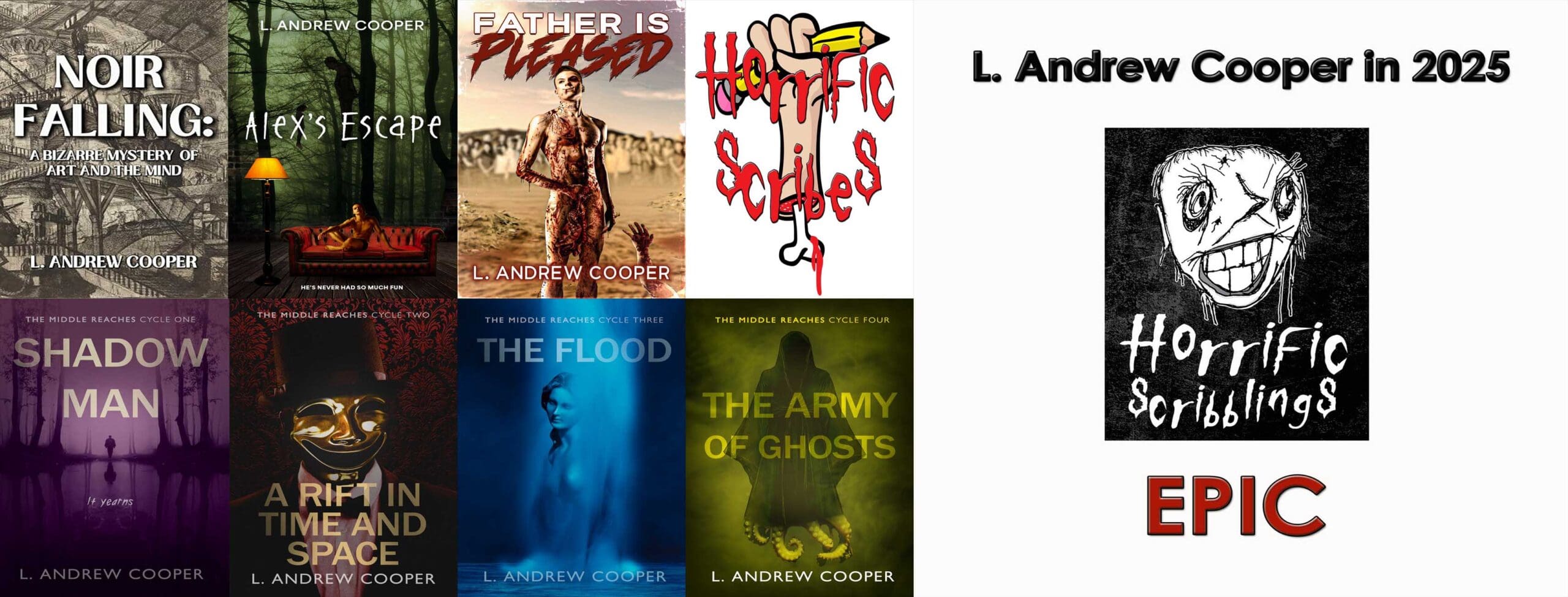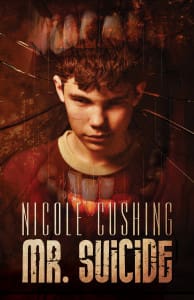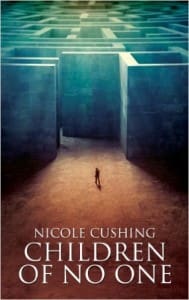Spotlight: Nicole Cushing’s Mr. Suicide (2015)
Book Synopsis: Like everyone else in the world, you’ve wanted to do things people say you shouldn’t do.
How many times in your life have you wanted to slap someone? Really, literally strike them? You can’t even begin to count the times. Hundreds. Thousands. You’re not exaggerating. You’re not engaging in… whatchamacallit? Hyperbole? You’re not engaging in hyperbole.
Maybe the impulse flashed through your brain for only a moment, like lightning, when someone tried to skip ahead of you in line at the cafeteria. Hell, at more than one point in your life you’ve wanted to kill someone; really, literally kill someone. That’s not just an expression. Not hyperbole. Then it was gone and replaced by the civilized thought: You can’t do that. Not out in public.
But you’ve had the thought…
Cover Art and Design by Zach McCain
Pub Date: July 15, 2015
Format: Trade Paperback, 224pp
ISBN-13: 978-1-939905-11-6
Format: eBook
ISBN-13: 978-1-939905-12-3
Interview
Extreme love. I love Mr. Suicide, but I wonder if that’s a problem. To explain: I am fond of my own extreme stories, and I want people to love them, but I also wonder what other people loving my extreme horror means. To illustrate: Anne Rice doesn’t go to such extreme places, and in her heyday she accommodated fans better than just about anyone, but she also got freaked out on occasion when fans asked her to sign various weapons and body parts. How do you feel about folks loving the extremes, the Perfect Monsters and Border Crossings, of Mr. Suicide?
It depends on what you mean by “loving”. Sometimes extreme horror fandom brings with it a frivolity that I wouldn’t want to encourage. I’m not sure I want to see anyone gleefully cosplaying my characters at a con, for example, or–as you mentioned–making strange signing requests. I say this not because I’m a killjoy or a stick in the mud. I say it because responding to my work with frivolity means that the transgressive incidents are being trivialized, and that’s not what my work is about.
Mr. Suicide isn’t intended to be read as a celebration of the foul. It’s intended to be read as a book that points out the world’s foulness only so it can be mourned. I wanted to use transgressive fiction as some of my literary heroes (Jack Ketchum and Hubert Selby, Jr., for example) have used it. I wanted to use it to address topics like trauma, mental illness, and a certain inner brokenness that–in worst case scenarios–can be a part of both.
Are there occasional moments of dark humor in the scenes you mention? More with the Border Crossing scene than with the Perfect Monsters scene, I believe. And even in the Border Crossing scene the dark humor is, in my opinion, gallows humor. When I go for laughs, I’m going for bitter laughs at the logical consequences of the protagonist’s intense foulness as well as despairing laughs in recognition of a Greater Foulness that is ultimately visited upon everything and everyone.
So far, most readers and reviewers seem to understand what I’m driving at, and respond to the work appropriately (i.e., “loving” the book because it mourns things that need mourning). That’s been quite gratifying to see.
Love in close quarters. The horror of Mr. Suicide is intimate, an effect you jack up by writing in the second person, a technique that fails, in my opinion, at least nine times out of ten but that you pull off by combining it with very specific characterization. What is your relationship with your… antihero?… and what sort of relationship do you want readers to form with him?
The main character of Mr. Suicide is a composite. Some aspects of his depression are based on my own experiences when I was a teenager, but I also drew on people in my family and other people I grew up around. For example, some of the character’s most disturbing drives are loosely based on those verbalized by a boy I knew in high school.
My imagination obviously plays a huge role, too. I relied on it to flesh out the protagonist, to make him his own person who is separate from anything I’ve ever encountered in my own life. I want the readers to experience the temporary delusion that he is as real as they are. I want the readers to feel as though they are tucked deep, deep into his brain and that they know–vividly–what it’s like to be him. This means he can’t merely be a Frankenstein’s monster of two or three personalities from my past, sewn together. No amount of lightning can animate such a literary creature. The whole of the character must be greater than the sum of his parts.
Fuck love. I could write essays based on your “Acknowledgments” but, for now, will limit myself to a review and this question. Using your discretion vis-à-vis content spoilers, could you tell potential readers a little about “anti-natalism” and how it informs Mr. Suicide?
Antinatalism (as I understand it) is the position that it is morally irresponsible to reproduce, because existence inevitably entails pain that exceeds pleasure. Nonexistence is reckoned to be a preferable condition on the grounds that, although it brings no pleasure, it also brings no pain. Philosopher David Benatar’s 2008 Oxford University Press book Better Never to Have Been: The Harm of Coming into Existence presents a plausible logical argument for antinatalism.
It’s worth mentioning that, in his book, Benatar wisely notes that he is not arguing that we should all kill ourselves. Instead, he’s arguing that we shouldn’t reproduce and thrust the horror of existence upon our progeny (who are better off not existing). In other words: antinatalism isn’t inherently pro-death. It’s anti-birth. It isn’t about stopping an existence that’s already started, it’s about taking care to not usher life into existence in the first place.
I was introduced to antinatalism through Thomas Ligotti’s book of philosophy (and literary criticism) The Conspiracy against the Human Race. (The idea is also a significant theme in much of Ligotti’s fiction and poetry.) Other figures who have been associated with antinatalism include Peter Wessel Zapffe and Arthur Schopenhauer.
I’m not one hundred percent sure I buy into antinatalism (or any philosophy, for that matter). I’m not temperamentally equipped to be a doctrinaire. But when I first read about antinatalism, it resonated with me. Without going into spoilers, I’ll just say that certain emotional tensions relevant to antinatalism help drive the second half of Mr. Suicide.
The Sorrowful Midwest. “The Ohio is an ugly, brown river flowing through ugly, gray towns” (98). Your prose skewers much of American culture, but Mr. Suicide’s Louisville setting, populated with religious and sexual hypocrites whose violence feeds the violence of the main character, seems to provide the pumping heart for much vitriol. On my first trip back to Louisville after reading your book, I saw more truth in the city. How critical is the setting for your story? Could Mr. Suicide happen elsewhere? Why or why not?
I set the book in Louisville because I live near Louisville and know it fairly well (as well as I know anywhere). I suppose its location at the crossroads of the Rust Belt and Bible Belt might make it uniquely situated as the ideal backdrop for my bleak book (especially since the protagonist experiences pressures associated with both fundamentalism and working class life).
But, then again, ugliness is a muse with no fixed address. An observant writer will spot (and be inspired by) the squalor in any city. Ramsey Campbell has his Liverpool. Hubert Selby, Jr. had his NYC. Henry Miller had his Paris. So, given the history of dark and/or transgressive literature, I think Mr. Suicide could have been set elsewhere if someone else had written it. But I wrote it, so it’s set in Louisville.
In the Mouth of Greatness. The title page tells us Mr. Suicide is “A Novel of The Great Dark Mouth.” Are more tales of The Great Dark Mouth coming, and do you see yourself developing a new kind of mythos? What general things might you Reveal to potential readers now?
The Great Dark Mouth made its first (enigmatic, low-key) appearance in my 2013 novella Children of No One. I wasn’t planning on ever writing about it again, but about halfway through the writing of Mr. Suicide it showed up of its own accord. (As characters do, sometimes.)
But I don’t think of Mr. Suicide as a sequel to Children of No One. At least, not exactly. The Mouth as it appears in Mr. Suicide is an actual character in the book. The Mouth as it appears in Children of No One is less of a character and more of a vague force that lurks in the background. But the books have similar themes and those who enjoyed Children of No One will probably find that their understanding of the Great Dark Mouth will be enriched by checking out Mr. Suicide.
I don’t have any plans, at the moment, to write additional works about the Great Dark Mouth. I don’t rule out writing about it in the future, though. It’s just that I have to be in a certain frame of mind to write about it. It has to emerge organically. Currently, I’m at work on a novel that will have nothing to do with the Mouth. So any future appearances of the Mouth won’t be for a while (if they happen at all).
About the Author: Nicole Cushing was born in June, 1973 – the youngest of four children. She was raised in rural Maryland. Despite the relative isolation, her hometown was within driving distance to various historical sites related to Edgar Allan Poe. She counts her school field trips to these sites as formative experiences that threw fuel on her already-morbid imagination. She holds degrees in psychology and social work.
Various reviewers have described her work as “brutal”, “cerebral”, “taboo”, “mind-bending” and “outré”. She has been touted as “the literary love child of Jack Ketchum and Poppy Z. Brite”. Her novella CHILDREN OF NO ONE was nominated for the 2013 Shirley Jackson Award. Her latest release is her debut novel MR. SUICIDE, published by Word Horde. Visit her at www.nicolecushing.com.
Extremes of Horror, Thought, and Talent: L. Andrew Cooper’s Review of Mr. Suicide

Mr. Suicide is the best new horror novel I have read in years, and Nicole Cushing accomplishes the coup through immersion in the perspective of a psychopathic child on a quest to erase existences, maybe those of family members, maybe his own. The book is not for readers who are easily offended or who don’t like their world-views challenged by sickening, disturbing thoughts and images, but if you like literature that turns the world upside-down, shakes out the bad parts, and puts them on display for all to examine, you must read Mr. Suicide NOW.
For an explanation of why I love this novel, keep reading. As always, nobody bribed me to do this work, and though I’ve met Cushing, we only know one another through the writer-convention circuit.
When I first saw the novel’s second-person prose, I scoffed. I’ve read many books that try sustained second-person narrative, and they almost all fail, but Cushing succeeds because she does not hesitate to give her “you,” the novel’s perspective character, both universal appeal and cringe-inducing repugnance. In solitary moments, he meets Mr. Suicide, who goads him to off himself, and sharing the character’s perspective, you aren’t “sure if Mr. Suicide [is] just in your head” (9). At least initially, the second-person writing processes the wilder experiences of the character in a familiar-enough manner to keep reader and character intimate: his thoughts might really be your thoughts, if you confronted the same things he did. His seemingly rational reactions to what seem like irrational circumstances could make others of “your” feelings familiar, too, especially if you’ve had your own dark moments, contemplating suicide but soldiering on: “You lived on, mostly out of spite” (25). These more common feelings help less common feelings slide by, such as the early admission, “The first person you wanted to kill was your mother” (2). Well, if you were the type of person who wanted to kill, the first person you knew was probably your mother, so she’d be a candidate, right? So if you accept at the outset that you’re a psychopath, all of these thoughts make sense, right? Cushing creates psychopathic intimacy that pushes thought beyond limits of traditional rationality.
Beyond rationality, the boundaries of conventional ideas and behaviors blur, which Cushing acknowledges by making a major destination in her psychopath’s quest a fetish club called The Border Crossing. While most readers will find the club and the in-novel magazine it echoes, Perfect Monsters, plenty shocking, the most shocking border crossing Mr. Suicide displays might be the ease and seeming naturalness with which the central character conflates sex and murder, how as you move through the story, you feel “the urge to kill infuse itself into your urge to fuck” (129). The aim of sex becomes destruction, preferably the destruction of someone vulnerable, regardless of the someone’s genitals (orifices can always be created). Having superficially consensual but still predatory sex with a girl who suffers from significant disabilities, the perspective character reflects, “Fucking her was like fucking disease, itself” (82). Fucking, itself, becomes disease: the psychopath taints everything you with pathology.
The diseased mind you inhabit in Mr. Suicide inhabits, in turn, a diseased world. While the degree of his psychopathy is difficult to place in proportion to anything, it is literally and figuratively at home with his mother, whose abusive attitude has roots in “some bizarre twist… Christian dogma [that] managed to coexist with all the vulgarity in her head” (3). Cushing puts social hypocrisy on display throughout the novel, especially when she turns to the topic of mental illness, which many characters in the novel perceive as the problem with her central character but about which no one responds with compassion or even appropriate containment. When a cop comes to the kid’s house after he commits an early act of violence, the cop berates him and asks him to explain his behavior. “‘And do not tell me you have a chemical imbalance,’” the cop says, “‘Jesus Christ, if I hear another teenager say they’re bipolar-schizophrenic this week, I’m going to go bipolar-schizophrenic, myself’” (53). The cop’s attitude allows the psychopath, rightly, to dismiss him as one of many “bullies,” and it also shows how the common misuse of terms such as “bipolar” and “schizophrenic,” two different conditions with strong genetic components into which people do not simply “go” as a result of common stress, leads people to ignore serious problems. The simultaneous scapegoating and ignoring of mental illness enables violence. The novel does not blame or preach; it shows ugliness through searing prose.
Exposing ugliness through riveting, dark passages becomes Mr. Suicide’s main business, a business that makes the book almost impossible to put down (I read most of it in a single sitting). Why?
“If you opened your eyes to the best parts of ugliness, then you had answers” (127).
Some of those answers appear in the ugliness the main character finds on the streets of Louisville, Kentucky:
“There was a certain psychological refreshment you found in abundance. There were other people walking around, too. A good dozen of them, treading the sidewalk either alone or in pairs or in trios. You’d never met any of these people before, but just by looking at them you felt a strong kinship… Like you, they were people who lingered in the dark…
Many also had backpacks. Many, also, had escaped the chains of hygiene. Some of the women looked like whores. Some of the men looked like sleepwalkers. Occasionally you saw an infant among their number and felt jealous that it would, from its earliest days, get to revel in the sort of life you’d had to wait eighteen long years to participate in.” (100)
Opening your eyes to these details of street life—people who are disaffected, dispossessed, and otherwise at the bottom of the social hierarchy—might reveal appeal in disassociation from the hypocrites and bullies whose dogmas and misinformation foster the very violence that shatters boundaries. Tune in, turn on, drop out.
In a world full of ugliness, escape into darkness is appealing sometimes, and that is the lure of Mr. Suicide, as well as Mr. Suicide, “a Novel of the Great Dark Mouth,” as its subtitle proclaims. The novel is about, and is, a cage of unwanting. You may want to dissociate from the character whose mind you’re in, but you can’t escape having one thing in common with him: you do not want to be there. Dissociation is an unbreakable line of empathy to a psychopath, and Cushing uses it to tether you to horrors that swallow you, digest you, and, if you keep your mind open to the answers that ugliness offers, make you want the Great Dark Mouth to open again.




